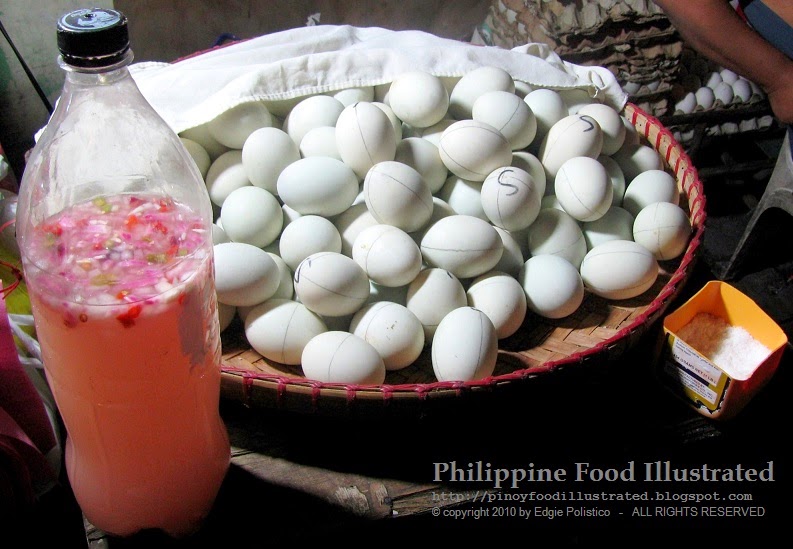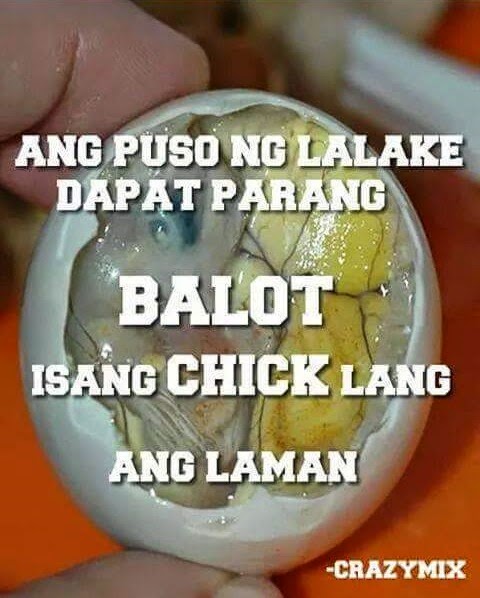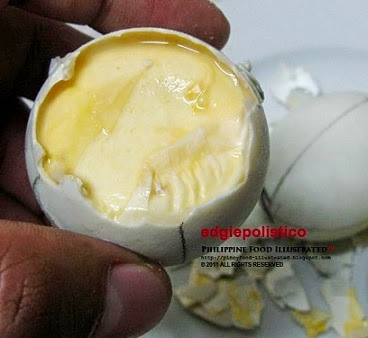balut - /ba-lùt/ (Tagalog [Metro Manilan, Lagueño and Bulaqueño), Batangueño, Mindoreño, Cebuano, Boholano, Waray, Ilonggo, Masbateño, Bicolano, Ilocano, Pangasinense, Itawis, Ibanag, and Capampangan, Surigaonon, and Zamboangueño delicacy) [n.] boiled fertilized egg of itik (mallard duck), approximately 16 to 19 days old of incubation with the almost fully developed embryo or chick inside the shell.
Other local name:
- a.k.a. balut sa puti in Tagalog
The cooked duck embryo of a fertilized duck egg is so-called balut sa puti because the biggest part of the embryo is still wrapped in egg white, fondly called by Pinoys as bato (stone) being the toughest part of balut that would require a lot of chewing to fully masticate it.
.JPG) |
| The famed balut sa puti is in the center stage among the pulutan (food served with the wines) when the classy Planet Grapes
of Tuscany, McKinley Hill in BGC introduces their concept of pairing
world-class wines with Pinoy street foods themed as "wine meets street
food." Here, a hard-boiled balut egg becomes the centerpiece. |
.JPG) |
| A table setting of Planet Grapes'
"wine meets street
food" with balut egg as the centerpiece on each plate. |
%2B-%2Bwatermarked.JPG) |
| Balut
has found also its way on classy food stalls such as this bucket of
balut eggs offered to customers at daytime Mercato Centrale in Bonifacio
Global City (BGC - The Fort), Taguig City |
%2B-%2Bwatermarked.jpg) |
Removing the shell before your eyes under an open light is not for the weak at heart. It is suggested that you eat balut without looking at the egg content, or better yet eat this while hiding in the dark.
|
Balut
is eaten by first cracking an opening at the tip of the egg by tapping it lightly
against a hard surface. Using the finger, the shards on the cracked portion are
removed to expose the veiny thin film that would easily peel off or burst open,
further exposing the watery content (amniotic fluid) of balut. More often, the thin film on the side would adhere and peel
off with the shard of the shell. A pinch of salt is then sprinkled into the
hole and/or doused with a little amount of vinegar.
%2B-%2Bwatermarked.JPG) |
| More
often, balut is cracked and opened only on the top
side, then a pinch of salt is sprinkled all over the
exposed boiled chick. The juice (amniotic fluid) is then slurped or sipped
out. |
The juice (amniotic fluid) in
the egg is immediately sipped out or slurped to savor the taste. When drained, the
rest of the shell is cracked open and discarded to expose the whole content of the balut.
Sprinkling more salt or dousing
more vinegar may be needed before biting or mouthing the whole content of the balut.
For those who cannot brave the
sight of the veiny yolk and the hairy dead chick, it is advised to take balut
at night or in a dark room or unlighted places. This probably is the reason why
balut is popularly sold and available in the streets at night.
Balut is not unique to the Philippines,
as it can be found also in other Asian countries where it is known to have another
name and is served or eaten with different condiments.
Balut is high in protein and is valued by Pinoys for its
nutritional benefits, considered by most locales as vigor enhancing delicacy
and as an aphrodisiac.
%2B-%2Bwatermarked.JPG) |
| Click
the image for you to find out why it is advised that you eat this
delicacy at night or under the cover of darkness. Disgusting for some.
It's yucky but yummy exotic food for those who have tried it. |
%2B-%2Bwatermarked.JPG) |
| Balut is sold in almost
all cities and big towns all over the Philippines. In
Bacolod City, the egg is always kept warm over a steamer
that is also used in heating boiled peanuts. |
.JPG) |
| In
Guadalupe Nuevo (Tulay), Makati City, workers would stop
to buy and eat balut from a sidewalk stall beside the
Guadalupe wet market. |
.JPG) |
| Vendors and bargain hunters in Divisoria of Tondo, Manila are also offered the delicacy. |
 |
| Balut has no marking - Marking boiled eggs with a distinctive line or mark using a pencil or pentel pen is done to easily distinguish balut sa puti from the balut penoy, such as this tray of balut with a bottle of spiced vinegar sold on the sidewalk under the viaduct in Alabang, Muntinlupa City. The marked eggs are the balut penoy, while the unmarked ones are balut sa puti. |
Production of balut is also done now in other
provinces throughout the country where eggs of itik are available.
The
famed balut in Pateros of Metro Manila no longer originates in this town after
duck farming was wiped out by the intrusion of modern development in Metro
Manila.
Most duck eggs used in making balut in Pateros are now sourced
from the duck raisers in Pampanga, Bulacan, and Nueva Ecija provinces.
Due
to the limited supply of duck eggs, commercially produced brown chicken eggs are
now fast becoming an alternative to making balut,
known as balut itlog manok.
While in Cebu City, balut is available day and night at the Fuente Osmeñia Park.
Balut eggs can
also be served in several ways. It can be cooked in tomato sauce to become balut caldereta or balut afritada, or in a soup like a balut a la pobre, and as paste or spread for bread, as in balut pate.
Though
considered a delicacy by some Pinoys, balut
is considered unclean or filth by the followers of the Islamic faith and is Haram (forbidden) in Islamic Laws because
it comes under the heading of eating maytah,
or that the animal has died without being slaughtered properly.
Eating maytah is definitely Haram according to Islam. Thus, balut should not be served to Muslims so
as not to offend or insult them.
 |
| Crazymix meme on FB |
Related posts:



All photos by Edgie Polistico are copyrighted. ALL RIGHTS RESERVED.
If you liked this post and our site, share it.
Let us know your opinion on the subject. Feel free to comment in the comment section, below. We need to know what you think.
Tell us what other topics you would like us to write, share, and discuss about.
Continue to follow my blogs. You can also follow and learn more by joining us in our Facebook group. Have more bits and pieces about our kind of food, ingredients, and ways of cooking, dining, and knowing food culture across the 7,641 islands of the Philippines.
Encouragement and enthusiasm are not enough. I also need moral support, prayers, and anything else that can uplift my spirit and keep my good reasons. Keep them coming. All I know is that I am happy with what I am sharing and giving away. If you are pleased and happy with what I am doing, just smile and please share the happiness. Keep sharing and include to share the PHILIPPINE FOOD ILLUSTRATED. I feel energized when my blog becomes one of the reasons why you are happy and smiling.
Edgie Polistico
















+watermarked.jpg)
watermarked.jpg)
watermarked.jpg)
+watermarked.jpg)
watermarked.jpg)
watermarked.jpg)



%2B-%2Bwatermarked.jpg)









